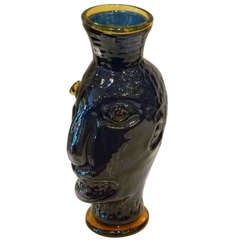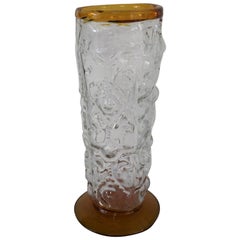Topaz Blenko
Recent Sales
Late 20th Century American Decorative Objects
Blown Glass
Late 20th Century American Modern Vases
Blown Glass
Blenko Glass for sale on 1stDibs
A producer of hand-blown glass since 1893, Blenko Glass is currently headquartered in Milton, West Virginia, where it has operated since 1921. Among its many illustrious projects are the stained-glass windows it produced for St. Patrick’s Cathedral and the Washington National Cathedral. Blenko is known today for the brilliant colors of its glass vases, decanters and other vessels and objects — particularly those produced in the 1950s and ’60s — which range from jewel-like blues and greens to brilliant reds and yellows.
The company was founded by William J. Blenko, an English immigrant who was apprenticed to a glassmaker in his native London as a young man. Blenko developed expertise in the production of rondels, the round panes used in stained glass windows.
Blenko's interest in the potential of natural gas to fire glass furnaces led him to Milton, where abundant reserves of the fuel had attracted a pool of skilled glassblowers. Under the name Eureka Glass, his company began making window glass in 1923, and in 1925, he was joined in the business by his son, William H. Blenko.
When the Great Depression quelled demand for stained glass, William J. Blenko brought local Milton glassblowers into the company to begin producing stemware and tableware, products for which the company, which changed its name to Blenko in 1930, is now best known.
Up until the end of World War II, Blenko’s tableware designs were fairly straightforward, and they sold well at American department stores such as Gump’s, in San Francisco. The company was also commissioned in 1930 to produce a line of reproductions for Colonial Williamsburg.
In 1947, the company hired as its art director Winslow Anderson, who introduced artful, fanciful and modern vessels and objects in vibrant colors. This began what collectors refer to as Blenko’s “historic period.” A number of Anderson’s designs were honored by the Museum of Modern Art’s Good Design Awards in 1950, and throughout the 1950s and ‘60s, the company enjoyed robust sales and critical acclaim. The forms Blenko produced during this period followed the contemporary vogue for biomorphism, or organic modernism, which favored rounded and fluid shapes inspired by nature.
One of Blenko’s most influential designers, Wayne Husted, who was active from 1953 to ’63, is credited with aligning Blenko’s products with the prevailing mid-century modern aesthetic by pushing the envelope on both form and color, particularly in his wedge-cut and Spool decanters and his Echoes series.
Joel Philip Myers, who designed for Blenko in the 1960s, brought a sense of whimsy and visual excess to the product line, in keeping with the psychedelic look favored during the period.
Blenko Glass still produces many of its classic designs in items ranging from stemware and tableware to decorative objects and ornamental decanters.
Among collectors, pieces created under Husted’s creative direction are of special interest. The company has come to the attention of younger audiences through the documentaries Blenko: Hearts of Glass and Blenko Retro: Three Designers of American Glass, both of which aired on PBS. Blenko also designed the glass award trophy for the Country Music Awards.
Find vintage Blenko glass for sale on 1stDibs.
Finding the Right Decorative-objects for You
Every time you move into a house or an apartment — or endeavor to refresh the home you’ve lived in for years — life for that space begins anew. The right home accent, be it the simple placement of a decorative bowl on a shelf or a ceramic vase for fresh flowers, can transform an area from drab to spectacular. But with so many materials and items to choose from, it’s easy to get lost in the process. The key to styling with antique and vintage decorative objects is to work toward making a happy home that best reflects your personal style.
Ceramics are a versatile addition to any home. If you’ve amassed an assortment of functional pottery over the years, think of your mugs and salad bowls as decorative objects, ideal for displaying in a glass cabinet. Vintage ceramic serveware can pop along white open shelving in your dining area, while large stoneware pitchers paired with woven baskets or quilts in an open cupboard can introduce a rustic farmhouse-style element to your den.
Translucent decorative boxes or bowls made of an acrylic plastic called Lucite — a game changer in furniture that’s easy to clean and lasts long — are modern accents that are neutral enough to dress up a coffee table or desktop without cluttering it. If you’re showcasing pieces from the past, a vintage jewelry box for displaying your treasures can spark conversation: Where is the jewelry box from? Is there a story behind it?
Abstract sculptures or an antique vessel for your home library can draw attention to your book collection and add narrative charm to the most appropriate of corners. There’s more than one way to style your bookcases, and decorative objects add a provocative dynamic. “I love magnifying glasses,” says Alex Assouline, global vice president of luxury publisher Assouline, of adding one’s cherished objects to a home library. “They are both useful and decorative. Objects really elevate libraries and can also make them more personal.”
To help with personalizing your space and truly making it your own, find an extraordinary collection of decorative objects on 1stDibs.

